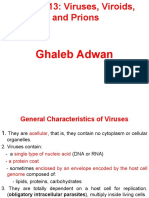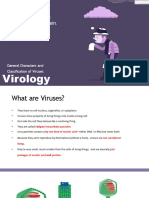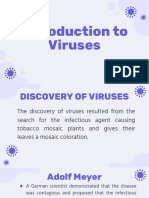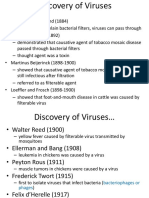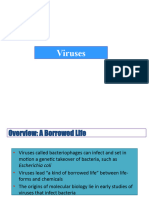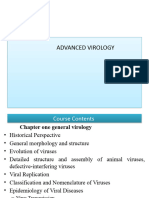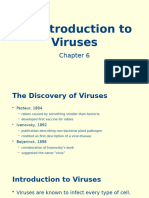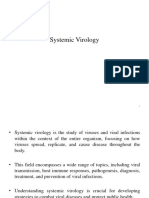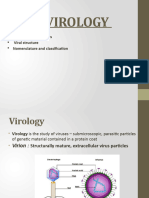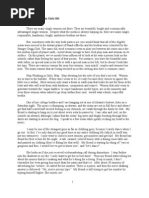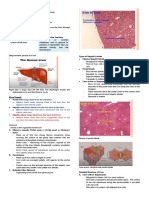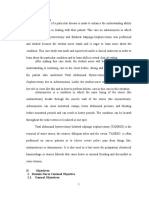Fungi & Virus
Fungi & Virus
Uploaded by
Jazz On WattpadCopyright:
Available Formats
Fungi & Virus
Fungi & Virus
Uploaded by
Jazz On WattpadOriginal Description:
Copyright
Available Formats
Share this document
Did you find this document useful?
Is this content inappropriate?
Copyright:
Available Formats
Fungi & Virus
Fungi & Virus
Uploaded by
Jazz On WattpadCopyright:
Available Formats
FUNGI
* Medical Mycology study of human diseases caused by fungi. * Eukaryotic microbes devoid of chlorophyll * Larger than bacterial cells * Unicellular or multicellular * Well developed nucleus with nuclear membrane and paired chromosome * Rigid cell wall containing chitin, mannan and other polysaccharides * Cytoplasmic membrane contain sterols * Reproduction asexual or sexual * They are resistant to antibiotics CLASSIFICATION A. BASIDIOMYCETES ( MUSHROOMS) B. ASCOMYCETES ( YEAST ) C. MOULDS OR FILAMENTOUS FUNGI D. DIMORPHIC/LICHENS Human fungal disease( mycoses) Location: cutaneous subcutaneous systemic Fungal cell wall Composed of chitin Fungal membrane- ergosterol Ergosterol Target of chemotherapeutic agents drugs that disrupt membrane function: Amphotericin B Nystatin Clotrimazole Ketoconazole miconazole Habitat and nutrition Heterotrophic (preformed organic carbon source for growth) Dont ingest food particles but depend upon transport of soluble nutrients across their cell membranes. Saprophytic
Some parasitic if in contact with soil, except Candida Fungal Growth 1. Filamentous ( mold-like) fungi vegetative body (thallus), mycelium, hyphae and reproduce by formation of different types of spores. Ex. Dermatophytes 2. Yeast like fungi grow partly as yeast and partly as elongated cells resembling hyphae ex. Candida albicans 3. Yeast- spherical or ellipsoid cells, reproduce by budding 4. Dimorphic grow as yeast in soil or in cultures, or moulds or filaments ex. Histoplasma capsulatum and other causing systemic infections. Cutaneous Mycoses Also known as dermatophytoses, characterized by itching, scaling skin patches ( scalp, pubic area or feet) 1. tinea pedis ( athletes foot) Trichophyton rubrum Trichophyton mentagrophytes Epidermophyton floccosum 2. Tinea corporis ( ringworm) Epidermophyton floccosum Several species of Trichophyton and Microsporum 3. Tinea capitis ( scalp ringworm) Trichophyton and Microsporum 4. Tinea cruris ( jock itch) 5. Tinea Unguim ( onychomycosis) Trichopyton rubrum Subcutaneous Mycoses Sporotrichosis Sporothrix sp(dimorphic) Chromomycosis Mycetoma Infection of the dermis, subcutaneous tissues and bone Systemic Mycoses 1. Coccidiodomycosis 2. Histoplasmosis 3. Blastomycosis
Candida Important human pathogens that are best known for causing opportunist infections in immunocompromised hosts (e.g. transplant patients, AIDS sufferers, cancer patients). Infections are difficult to treat and can be very serious: C. albicans Aspergillus Some Aspergillus species are pathogenic and can cause serious disease in humans and animals. Aspergillus fumigatus and Aspergillus flavus. A. flavus-produce aflatoxin Aspergillosis is the group of diseases caused by Aspergillus. The symptoms include fever, cough, chest pain or breathlessness. Usually, only patients with weakened immune systems or with other lung conditions are susceptible. Cryptococcus Cryptococcus neoformans can cause a severe form of meningitis and meningoencephalitis in patients with HIV infection and AIDS. Histoplasma Histoplasmosis, also known as Darling's disease, is a disease caused by the fungus Histoplasma capsulatum. Symptoms of this infection vary greatly, but the disease primarily affects the lungs. Occasionally, other organs are affected; this is called disseminated histoplasmosis, and it can be fatal if untreated. Histoplasmosis is common among AIDS patients because of their lowered immune system
VIRUS
DO VIRUS CONSIDERED NON LIVING? Ans: according to majority of virologist, they do not meet all the criteria of the generally accepted definition of life. o Do not posses a cell membrane or metabolise on their own.
o Can reproduce by creating a multiple copies of their own but they do not posses a cell structure. VIRUS Latin word means poison or toxin Submicroscopic particle that can infect the cells of a biological organism. Do not metabolise on their own and therefore require a host cell to replicate and synthesize a new product. Why virus hard to kill? Parasites incapable of reproducing on their own. Inactive form, not unless they burrow into a host cell, taking over its functions in order to replicate and thereby destroying the host. Vulnerable to drugs only after they invade a cell, but any treatment may damage the cell as well. Viruses can suddenly mutate.Potentially becoming deadlier and even tougher to eliminate with effective vaccine or anti viral drugs. How long does it take for HIV to cause AIDS? HIV develops AIDS within 10 years after becoming infected. Varies greatly from person to person and can depend on many factors, including a person's health status and their health-related behaviours. MORPHOLOGY VIRUS Smaller in size 20 to 300 nm Either DNA or RNA No cellular organization No enzyme for synthesis of protein and nucleic acid Obligate intracellular parasites not affected by antibiotics Filterable through bacterial filters Too small to be seen under light miccroscope and are called ultra microsopic INFECTIOUS AGENT VIRUS VIRAL COMPONENTS 1. NUCLEIC ACID Genome either DNA or RNA, but not both
Protein containing structure ( capsid), design to protect the genome Additional structural features Envelope protein containing lipid bilayer, can be present of absent 2. CAPSID Protein shell that encloses nucleic acid ( genome) Protection of nucleic acid/genome Promotion of attachment of virus to the susceptible host cell 3. ENVELOPE a membrane covering surrounding the capsid May possess projections called spikes or peplomers which function as haemagglutinin Confers chemical, antigenic and biological properties RNA VIRUS HIV( human immunodeficiency virus) HIV is so hard to kill: it's a virus that uses evolution within the host to adapt to its local environment. Infects the T cells(T4 lymphocyte cells) or helper cells infection with HIV can weaken the immune system to the point that it has difficulty fighting off certain infections.
Blood Semen vaginal fluid breast milk other body fluids containing blood How does the HIV Virus infect The T Cell? First the virus binds to the cell via the CD4 receptor on the cell membrane. After it binds to the cell, the virus penetrates the cell membrane and releases the HIV RNA into the cell. Within the cell, the HIV RNA undergoes reverse transcription where the RNA codes for the HIV DNA. This new DNA strand then enters the cell's nucleus where it codes for more RNA. These RNA strands are then released into the cytoplasm where they are translated into protein, which then form the capsoid that carries the new HIV RNA. In the final step the new HIV virus' collect along the cell membrane budding on the edge of the membrane. Finally, when the cell membrane can no longer hold all of the HIV, it explodes releasing the HIV into the body. CLASSIFICATION OF VIRUS Four main characteristics : Nature of the nucleic acid: RNA or DNA Symmetry of the capsid Presence or absence of an envelope Dimensions of the virion and capsid STRUCTURE Helical Icosahedral Enveloped Complexed HELICAL Helical capsids are composed of a single type of capsomer stacked around a central axis to
These body fluids have been proven to spread HIV:
form a helical structure, which may have a central cavity, or hollow tube Ex. Tobacco mosaic virus ICOSAHEDRAL Most animal viruses are icosahedral or nearspherical with icosahedral symmetry. The minimum number of identical capsomers required is twelve, each composed of five identical sub-units. Capsomers on the triangular faces are surround by six others and are call hexons. ex: rotavirus ENVELOPED Some species of virus envelope themselves in a modified form of one of the cell membranes, either the outer membrane surrounding an infected host cell, or internal membranes such as nuclear membrane or endoplasmic reticulum, thus gaining an outer lipid bilayer known as a viral envelope. CLASSIFICATION Based on Type of nucleic acid: 1. Ribovirus containing RNA these are called RNA viruses 2. Deoxyriboviruses viruses containing DNA these are DNA viruses RNA VIRUSES 1. Picornaviridae family Enteroviruses ex. Polivirus Rhinovirus ex. Rhinoviruses Hepatovirus ex. Hepatitis A virus 2. Orthomyxoviridae ex. Influenza virus 3. Paramyxoviridae ex. Mumps, para infuenza, respiratory syncytial 4. Rhabdoviridae ex. Rabies 5. Coronaviridae ex. Coronavirus 6. Reoviridae ex. Rotavirus 7. Retroviridae ex. HIV 8. other families like Arbovirus, Hantavirus, and many other virus DNA VIRUS 1. Poxviridae- ex. Poxvirus
2. Herpesviridae- ex. Herpes viruses 3.Adenoviridae ex. Adenovirus 4. hapadnavirus ex. Hepatitis B 5. Papoviridae ex. Papilomavirus and polyomavirus 6. Parvoviridae- ex. parvovirus
VIRAL REPLICATION A. LYSOGENIC CYCLE -A viral replication cycle in which the virus does not destroy the host cell but coexists within it. B. LYTIC CYCLE - A viral replication cycle in which the virus destroys the host cell. BACTERIOPHAGE Viruses that affect bacteria are called bacteriophages, or simply phages (pronounced FAY-jez). AIDS Caused by human immunodeficiency virus belonging to retrovirus Spherical enveloped virus RABIES Caused by rabies virus( Rhabdovirus) Bullet shape RNA surrounded by a membranous envelope with spikes HEPATITIS A Non envelope virus Infection occurs bye ingestion ( mouth) INFLUENZA Caused by Orthomyxoviruses Enveloped and posses two spikes Acute respiratory disease characterized by abrupt onset of chills, fever, sore throat, cough MEASLES Caused by Paramyxovirus Spherical German measles is caused by Rubella virus LIFE CYCLE
You might also like
- Test Bank For Human Physiology 15th Edition by Stuart FoxDocument11 pagesTest Bank For Human Physiology 15th Edition by Stuart Foxpalmarycoppinji0No ratings yet
- Bhanu Desai How To Select SimilinumDocument53 pagesBhanu Desai How To Select SimilinumNitesh100% (5)
- CH 12 Instructor GuideDocument11 pagesCH 12 Instructor GuideVee Nara0% (1)
- Microbiology VirusesDocument66 pagesMicrobiology Virusesanticlock81No ratings yet
- Viruses BasicsDocument53 pagesViruses Basicsmokashe1987No ratings yet
- Virus General AllDocument41 pagesVirus General AllAaQib BhatNo ratings yet
- VirologyDocument42 pagesVirologycandicealoneNo ratings yet
- chapter-4-ACELLULAR AND PROKARYOTIK MICROBESDocument66 pageschapter-4-ACELLULAR AND PROKARYOTIK MICROBESCza Mae ArsenalNo ratings yet
- 2nd-Topic Science NursingDocument28 pages2nd-Topic Science NursingMaria Gloria Aquino BorjaNo ratings yet
- Viruses Characteristics and Morphology and TaxonomyDocument46 pagesViruses Characteristics and Morphology and Taxonomyurwashazadi55No ratings yet
- VirologyDocument18 pagesVirologyyassirolarewajuNo ratings yet
- Bot 101 VirusesDocument15 pagesBot 101 VirusesToluwalase GbadamosiNo ratings yet
- Introduction To VirusDocument28 pagesIntroduction To VirusRobert B.weideNo ratings yet
- VirologyDocument62 pagesVirologyOsman HassanNo ratings yet
- Pathogens and InfectionDocument34 pagesPathogens and InfectionIngrid Anaya MoralesNo ratings yet
- Chapter 4Document54 pagesChapter 4jovendiestro822No ratings yet
- Medical Biology Lecture 6Document35 pagesMedical Biology Lecture 6Yaqeen AlaidyNo ratings yet
- Cluster 8 Microbiology Lesson 1Document24 pagesCluster 8 Microbiology Lesson 1JudithNo ratings yet
- VirologyDocument31 pagesVirologySaad HassanNo ratings yet
- Viruses: Black, J.G.. Microbiology: Principles and Explorations, Latest Edition Chap 10Document43 pagesViruses: Black, J.G.. Microbiology: Principles and Explorations, Latest Edition Chap 10راما عصفورNo ratings yet
- Chapter 2 - VirusDocument26 pagesChapter 2 - Virusshahera rosdiNo ratings yet
- Medical VirologyDocument23 pagesMedical Virologyour lectureNo ratings yet
- VirologyDocument51 pagesVirologyJhann100% (2)
- Viruses - For XDocument40 pagesViruses - For XsepuluhtigaNo ratings yet
- Lecture 1 General Properties of Viruses 2021Document70 pagesLecture 1 General Properties of Viruses 2021Suresh Krishnani0% (1)
- VirusesDocument55 pagesVirusesabdullahjavid195No ratings yet
- Virus FDocument53 pagesVirus FFuad Hasan Pranto 1921147049No ratings yet
- V. Micro 151 Introduction To VirusesDocument69 pagesV. Micro 151 Introduction To Viruseseren16jaegerNo ratings yet
- Viruses - GoodDocument50 pagesViruses - GoodMohammed Faraaz MustafaNo ratings yet
- General Virology BCH-411 DR - Kalsoom SughraDocument44 pagesGeneral Virology BCH-411 DR - Kalsoom SughraAmina KhanNo ratings yet
- VirusesDocument40 pagesVirusesRimayaniNo ratings yet
- Dr. Keli Mem203 VirologyDocument162 pagesDr. Keli Mem203 Virologykaregagladys90100% (1)
- Science 7 Viruses Bacteria Protist FungiDocument52 pagesScience 7 Viruses Bacteria Protist FungiWelfredo Jr YuNo ratings yet
- VirusesDocument76 pagesVirusesAbd ahmadNo ratings yet
- VirusesDocument50 pagesVirusesNica Aripal Aljas JustinianeNo ratings yet
- VirologyDocument94 pagesVirologyADUGNA DEGEFENo ratings yet
- Lec ch1+2-1Document35 pagesLec ch1+2-1trhwj9bpnkNo ratings yet
- 06+an+Introduction+to+Viruses%2C+Viroids%2C+and+PrionsDocument40 pages06+an+Introduction+to+Viruses%2C+Viroids%2C+and+Prionsqw8kngb4mqNo ratings yet
- Systemic VirologyDocument130 pagesSystemic Virologygetachewketema5No ratings yet
- VIRUSESDocument29 pagesVIRUSEStria nurdianaNo ratings yet
- Bel11Document6 pagesBel11zeynepipadsNo ratings yet
- Microbiology For The Health Sciences: Chapter 4. Diversity of MicroorganismsDocument59 pagesMicrobiology For The Health Sciences: Chapter 4. Diversity of MicroorganismsHiba Abu-jumahNo ratings yet
- Introduction To MycologyDocument44 pagesIntroduction To MycologyPrincewill SeiyefaNo ratings yet
- Study of VirusDocument13 pagesStudy of VirusS A N K A RNo ratings yet
- Virus Replication FinalDocument59 pagesVirus Replication FinalSubhas KarnaNo ratings yet
- Acellular LifeDocument44 pagesAcellular LifeAqeelaNo ratings yet
- Gram Negative SpirochetesDocument50 pagesGram Negative SpirochetesYeshiwas FelekeNo ratings yet
- 7 Viral Cultivation and PropagationDocument29 pages7 Viral Cultivation and Propagationhamza najmNo ratings yet
- Viruses, Bacteria, Protists and Fungi: Module Two: Life at A Molecular, Cellular and Tissue Level Paper OneDocument52 pagesViruses, Bacteria, Protists and Fungi: Module Two: Life at A Molecular, Cellular and Tissue Level Paper Oneapi-279296553No ratings yet
- Virologyintro 180422150307 PDFDocument30 pagesVirologyintro 180422150307 PDFSam AbuGhozie AhmadinovNo ratings yet
- TuberculosisDocument52 pagesTuberculosisSamina AhmedNo ratings yet
- Lecture 2 VirologyDocument38 pagesLecture 2 VirologymuskanbakaliNo ratings yet
- Lesson 6 Introduction To VirologyDocument20 pagesLesson 6 Introduction To VirologyNOR-FATIMAH BARATNo ratings yet
- Clincal Mycology LecturesDocument35 pagesClincal Mycology LecturesolusuyitomiwaNo ratings yet
- OptomeDocument43 pagesOptomeabbasbelkoaishaNo ratings yet
- Virus PDFDocument60 pagesVirus PDFrenz bartolomeNo ratings yet
- Liaskos - Medical Bacteriology Lecture 1Document47 pagesLiaskos - Medical Bacteriology Lecture 1dalaleden3No ratings yet
- Virus byDocument120 pagesVirus byYashfa Yasin100% (2)
- General Characteristics of Viruses:: VirologyDocument12 pagesGeneral Characteristics of Viruses:: VirologyJamine Joyce Ortega-AlvarezNo ratings yet
- Assignment: ON Topic: Pox Viridae General Properties, Dna Replication & Cow Pox DiseaseDocument8 pagesAssignment: ON Topic: Pox Viridae General Properties, Dna Replication & Cow Pox DiseaseVinayak ChuraNo ratings yet
- Biology for Students: The Only Biology Study Guide You'll Ever Need to Ace Your CourseFrom EverandBiology for Students: The Only Biology Study Guide You'll Ever Need to Ace Your CourseNo ratings yet
- Ancel Keys - Atherosclerosis: A Problem in Newer Public HealthDocument22 pagesAncel Keys - Atherosclerosis: A Problem in Newer Public Healthacolpo100% (1)
- Urinary SystemDocument49 pagesUrinary SystemSalum Ahmadi100% (1)
- Beef - WikipediaDocument24 pagesBeef - WikipediafawxesNo ratings yet
- Getting Hot Chicks: Stop Flunking in Girls 101Document4 pagesGetting Hot Chicks: Stop Flunking in Girls 101Ari Meier100% (119)
- Liver and GallbladderDocument2 pagesLiver and GallbladderDanielle CapangpanganNo ratings yet
- Cephalometric Assessment of Post Treatment Vertical Changes in Patients Undergone Fixed Orthodontic TreatmentDocument16 pagesCephalometric Assessment of Post Treatment Vertical Changes in Patients Undergone Fixed Orthodontic TreatmentPuneet JainNo ratings yet
- 10 Most Poisonous Animals in The WorldDocument21 pages10 Most Poisonous Animals in The WorldDr.K.M. AbdullaNo ratings yet
- Tigernuts Flour / Harina de ChufasDocument11 pagesTigernuts Flour / Harina de ChufasBeida Omenesa VictorNo ratings yet
- Summary Writing Skills For SPMDocument70 pagesSummary Writing Skills For SPMSiti IlyanaNo ratings yet
- ControlDocument12 pagesControlSirVietaNo ratings yet
- Treasures of The Realms - Magic Items & Weapons of FaerûnDocument37 pagesTreasures of The Realms - Magic Items & Weapons of FaerûnKristiaanViles100% (10)
- Incident ReportDocument3 pagesIncident Reportthuynh12No ratings yet
- Female Uterine Disorders (Sy 2008-09)Document150 pagesFemale Uterine Disorders (Sy 2008-09)Jasmine Faye D. MadrigalNo ratings yet
- Complete One Word-Substitution Complete One Word-SubstitutionDocument18 pagesComplete One Word-Substitution Complete One Word-SubstitutionTechmaxNo ratings yet
- Malignant HyperthermiaDocument57 pagesMalignant HyperthermiaSuvadeep SenNo ratings yet
- Excessive Gingival Display - FinalDocument11 pagesExcessive Gingival Display - FinalPhilippe Bocanegra FernándezNo ratings yet
- Textile BasicsDocument11 pagesTextile BasicsPriyank AcharyaNo ratings yet
- Physio4all... : Sagar NaikDocument20 pagesPhysio4all... : Sagar NaikabrehaNo ratings yet
- Embark ResultsDocument31 pagesEmbark Resultsapi-149926365No ratings yet
- The Muscular System: Parts & FunctionsDocument4 pagesThe Muscular System: Parts & FunctionsNeil AdelanNo ratings yet
- Chaithanya KeyDocument2 pagesChaithanya KeyShrutheeNo ratings yet
- OrDocument56 pagesOrRosalyn YuNo ratings yet
- Principles of Wound ClosureDocument6 pagesPrinciples of Wound ClosureMarnia SulfianaNo ratings yet
- End of Respiration, Beginning of Reproduction TranscriptionDocument7 pagesEnd of Respiration, Beginning of Reproduction TranscriptionmarthafaragNo ratings yet
- Thesis (Effect of Curcuma Longa On Human Sebum Secretion)Document18 pagesThesis (Effect of Curcuma Longa On Human Sebum Secretion)Jolaine ValloNo ratings yet
- Fetal DistressDocument32 pagesFetal DistressMadhu Sudhan PandeyaNo ratings yet
- 23 Veterinary AcupunctureDocument9 pages23 Veterinary AcupunctureRosa Perea BullónNo ratings yet





